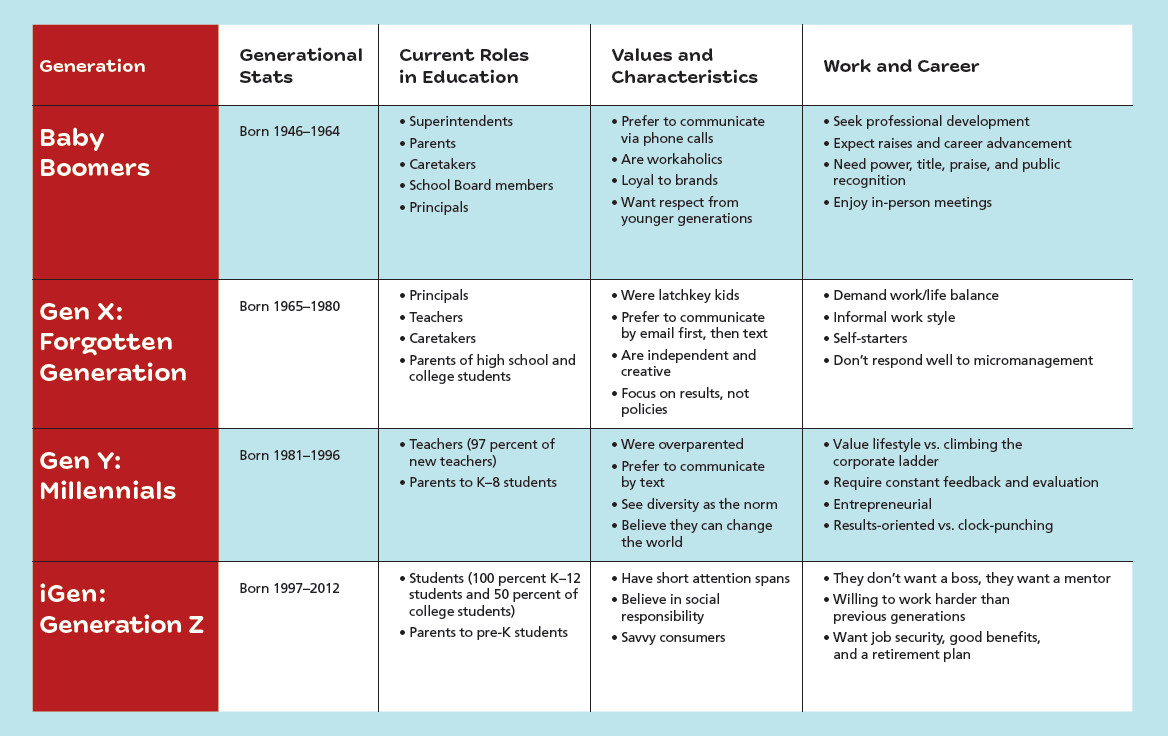Engagement Across the Generations
With at least four age groups represented in schools, communications must reach parents in every medium to be effective.
Topics: Principal Leadership, Teacher Effectiveness
With at least four age groups represented in schools, communications must reach parents in every medium to be effective.
By Dillon Kalkhurst
Principal, November/December 2019. Volume 99, Number 2.
Schools are facing real challenges in the way they communicate with today’s younger, busier, and more tech-savvy parents. A 2016 Gallup study of superintendents found that less than 6 percent feel they have a strong understanding of how to engage millennial staffers and parents, but the generational divide doesn’t end there.
For the first time in history, there are five generations active in the U.S. economy. In 1910, the average life expectancy was under 50 years of age. There were young people and older adults, but at work and school, communication was generally more straightforward between adjacent generations. Today, we live well into our 70s, on average, and we work for 50 years or more, creating “age diversity” issues.
Most of today’s K–5 schools have parents and caretakers from at least four generations. The majority are millennials (born 1981–1996) and Generation X (born 1965–1980). There is a small but growing percentage of Gen Z parents now entering the workforce (born 1997–2012). And many principals are welcoming baby boomer grandparents to school as students’ primary caretakers due to life circumstances.
Changes in Communication
Circumstances have changed a lot since the 1990s. When my son—now 22 and studying to become a high school special education teacher—was in elementary school, we checked his backpack every Tuesday for a folder of important things parents needed to know. Today, if you want to boost engagement and communicate effectively with parents, this type of one-size-fits-all communication strategy no longer works. You have to use multiple tools to engage.
Communication starts on Day One by asking parents how they prefer to receive information. You’ll be surprised by the variety of responses. As a general rule, boomers prefer phone calls and face-to-face conversations. Gen X parents were the first generation to hear AOL’s “You’ve Got Mail” and are now masters at managing vast amounts of email; they also like to text and visit school websites.
Older millennials—now in their late 30s—are the heaviest users of Facebook, so providing “sharable” moments from family engagement activities works to promote a positive school culture and attract more families. Younger millennials and Gen Z parents prefer Snapchat, Instagram, YouTube, FaceTime, and text, and they rarely use their mobile phones to make calls. Only 14 percent actively participate on Facebook, but they do use it to see what’s going on with older relatives, friends, and favorite brands, including your school’s PTA.
You must replicate family engagement communications across all media to reach everyone. You must also keep messages short and to the point. Millennial parents have an eight-second attention span. Make sure you outline the key points you want to get across in the first eight seconds of your webpages, social media posts, and printed newsletters.
Generational differences (click to enlarge)
Millennial-Friendly
Millennials are not the passive parents Gen Xers had, however, and “the teacher is always right” is mostly a boomer mindset. Millennial parents want to be part of their child’s education process. Teachers should ask parents for regular input and keep them informed about the reasoning behind specific assignments. Today’s parents will question everything and have hundreds of parenting and education “experts” available at the swipe of a finger. If you don’t answer their questions, they will find the answer somewhere else.
PTA membership has declined consistently over the past decade. Millennial parents question the value of dues-based memberships when they feel they can get the same benefits online at no charge. Millennials don’t join things; they start things. Don’t expect new parents to come to school ready to jump on a train that’s already moving. They want you to stop the train and ask them if they’d like to add a new car.
It’s not just schools—take a look at millennial freshman U.S. representatives. They did not go to Washington to join; they went to start something new. Young parents are the same way. Engage them early and often.
Effective communications are the foundation of a great school culture. It is critical to engage and embrace your school’s age diversity internally and externally to ensure that everyone who wants to contribute is given the opportunity.
Dillon Kalkhurst is the founder of The Center for Intergenerational Engagement and author of Generation Everyone! A Guide to Generational Harmony @ Work, School, and Home.
Copyright © National Association of Elementary School Principals. No part of the articles in NAESP magazines, newsletters, or website may be reproduced in any medium without the permission of the National Association of Elementary School Principals. For more information, view NAESP’s reprint policy.


